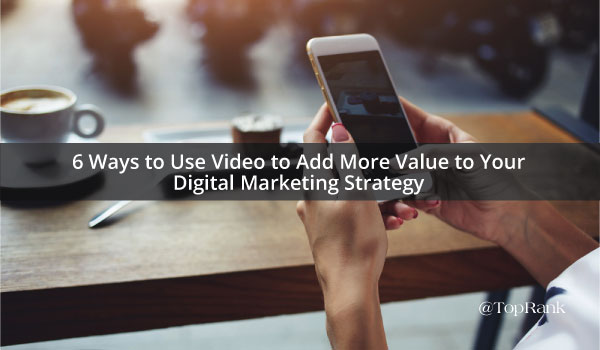
Humans are highly visual beings, so it’s certainly no surprise that online video content is becoming a favorite source of information and entertainment across the digital landscape—and it shows no signs of slowing down.
According to a HighQ infographic, experts believe that 69% of consumer Internet traffic will be from video by 2017—and that number will rise to 79% by 2018. As a result, video is becoming an increasingly important tool for marketers as they work to capture audience attention, provide value and increase engagement across their digital properties. In fact, the same infographic reports that 52% of marketing professionals worldwide name video as the type of content with the best ROI.
While video can sometimes be more costly and time consuming to produce, the good news is that video content can take on a variety of forms, giving marketers the ability to choose the style and platforms that suit their audience, objectives and strategy best.
Below we dive into a few different ways that marketers can add more video content to their digital marketing strategy, examples of how others are doing it and some best practices.
#1 – Use Video as Your Content Visual
Compelling images are an absolute must for any piece of content, but marketers can move beyond photos and use video to add meaning or flavor to written content.
For example, video is a huge part of AOL’s news content structure. Generally speaking, it’s unlikely that articles are without a supporting video at the top of the page. Whether it’s a lifestyle piece or a hard news post, AOL continually uses video to add a compelling visual element to their content.

As another example, TopRank Marketing has also taken to using video to add a visual dynamic to our weekly online marketing news roundup. Rather than just giving our readers a collection of industry articles and their links, Account Manager Tiffani Allen and Content Marketing Lead Josh Nite provide humor and insight on the trending topics.
Best Practice: Don’t use video just to have a video. Make sure that the content is relevant to your audience and provides value.
#2 – Live Streaming Video on Social Media
Live streaming video content on social media using apps and features such as Meerkat, Facebook Live or Twitter’s Periscope can help you form a deeper connection with your audience. How? Not only are you giving them something in real-time, but live video content often feels less scripted and more authentic—which is great for building trust with your audience.
Some of the brands that are using live streaming video content include GE, Adidas, Doritos and Spotify. Here’s an example of GE’s #DRONEWEEK on Periscope, showing live video footage of a GE-engineered drone flying from coast to coast.
Best Practice: Consider using live streaming video to give your audience either a sneak peak at an upcoming event or make a special announcement. Use social media to tease the upcoming announcement or sneak peek so people can tune in and participate.
#3 – Video Interviews with Industry Experts
Partnering with an industry experts or thought leaders can lend credibility to your content, provide additional value to your audience and extends your reach to a potentially new audience.
Author and genealogy speaker Lisa Louise Cooke often conducts video interviews with other family history experts to talk about new technologies, resources or trends. She also hosts a podcast.
Best Practice: Create pre-written social messages or blog post boiler to share with the experts you’re interviewing. This will make it easy for them to promote the interview before and after it happens.
#4 – Product Demos
Product demos can be an excellent way to visually highlight your product, propel brand awareness and educate your audience.
One adorable example of a product demo video comes from iFetch, the maker of the Automatic Ball Launcher pet toy. The video shows how both humans and dogs of all kinds can use the toy for hours of fun. While the video is a little on the longer side, you can’t deny how much you want to try it out with your own pet.
Best Practice: Before you jump in and start filming, create a storyboard to help you plan out how you’ll walk your audience through the demo. This will help you deliver a final product that is focused and valuable to your audience.
#5 – Video How-Tos
How-to video content is incredibly effective because it gives people the knowledge and know-how they need and want.
A fantastic example—as well as a favorite of mine—are the epically delicious recipe how-to videos on from Tasty on BuzzFeed. This video for Breakfast Enchiladas was published on May 15, 2016. The video has already received nearly 75,000 views.
Best Practice: Make sure to supplement how-to videos with a text version. This will allow you to optimize for search engines, the hearing impaired and for those who prefer written step-by-step instructions.
#6 – Customer Testimonials
A customer testimonials page is pretty standard practice these days, but why not take it to the next level by turning those raving reviews into compelling videos? Video testimonials allow your audience to see how your product or service can provide a solution to their problem or enrich their life.
Tesla Motors, the electric car maker known for unbelievable innovation, has created several video testimonials—or “customer stories” as they call them—to highlight a variety of people who’ve chosen Tesla.
Best Practice: Video testimonials have to be real. Don’t fake it because you’ll risk damaging the trust and credibility you’re trying to bolster with your audience.
How are you using video in your digital marketing strategy? Tell us in the comments section below.
Header image via Shutterstock


